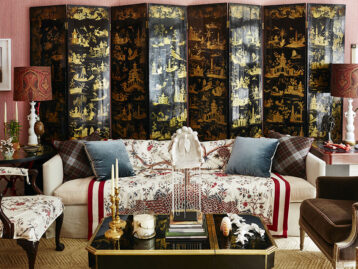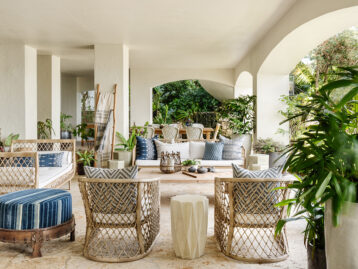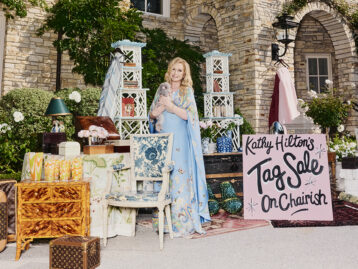Not many vintage and antique stores have a “pilot” and “copilot” in charge rather than old-fashioned owners, but the Dust Shuttle does things… a little differently, shall we say. Founded by two twentysomethings who grew up with a passion for art, antiques, and classic flea markets, the company is a mobile antique store that literally travels the country, collecting and selling one-of-a-kind items, particularly mid-century pieces. They’ve been across the U.S., making incredible finds as well as educating Gen Z about the virtues of vintage furniture and art.
We spoke with founder Bryce Detweiler about his journey to launching the Dust Shuttle, how he finds his best vintage furniture, and the stories behind some of his most memorable travels. Read on to see what he had to say, and be sure to shop the Dust Shuttle’s current crop of vintage pieces.

First and foremost, how did you get started in the vintage business, and where did the idea for the Dust Shuttle come from?
I learned about vintage design from my mentor Fred Irving; he introduced me to a lot of things and really shaped who I am as a person. I wasn’t exposed to much art as a kid, but in high school I dated Fred’s daughter Emma and spent more time at their house than my own. Their home was cool and was filled floor to ceiling with interesting objects the likes of which I’d never seen. And Fred had amassed it all on a budget. He worked for himself as a residential painter and would go to thrift stores between jobs and flea markets on the weekends. He was rarely willing to spend more than a few bucks, and yet this man’s collection was shocking. Fred started taking me to the flea market and I slowly learned the ropes. Pretty soon we were getting up at 5am to hit the market by ourselves. Shortly after that our business partnership developed and still persists today.
The Dust Shuttle was a vision on the horizon even back then. Being from a small town, I always loved the idea of travel and growing up watching The American Pickers I saw a life I envied. I ended up going away to college at West Chester University in Pennsylvania, where I met Chad Forman, my best friend, roommate, and copilot on the first Dust Shuttle trip. He grew up in the antiques business too, selling rocks and minerals at The Golden Nugget flea market when he was in second grade.
When I graduated with both a bachelor’s and a master’s in philosophy I didn’t have a whole lot of job prospects (go figure). I worked at Brigg’s Auction as a cataloguer then got laid off due to the pandemic. I was thrilled to be out of a job. Since high school, I had never stopped selling things and I wanted to see if I could really sustain myself with it. In short, it worked, but after a year of sheltering in place due to the pandemic, both Chad and I were thirsty for an adventure. All the down time had given me a chance to build up the infrastructure of my business and it seemed like the right time to take the show on the road. So we started planning, and The Dust Shuttle was born.

Tell us about some of the places you’ve traveled and the items you’ve encountered. Where would you most like to travel with your business?
We traveled from our home base in Media, Pennsylvania, down through Nashville into Florida, then across the country to Las Vegas where we rolled in on July 4th. From there we went to Zion National Park, then to San Diego by way of Arizona. After San Diego, it was all the way up the coast to Seattle, where we turned around for home, making a few stops along the way including a short stay at Glacier National Park.
We picked interesting items from all over, but the highest density we found was in Arizona and Florida—retirement states. One of my favorite items from the road trip was a prototype “Eshu” sofa by Roger Sveian that we bought from a man named Lars up in Northern California. We found him, or rather he found us, because he happened to be walking his dog by the van while Chad and I were loading up some items in the parking lot of an antique store near his house.
Another memorable pick was in Los Angeles. We were staying with Chad’s uncle in Silver Lake, and would walk everywhere to avoid reparking the van. Every day I’d end up walking by this house that had a car in its driveway with mid century stuff strapped to its roof. I’d walk by later and the stuff would be gone or replaced by something else. Finally I decided to knock on the door and see what was going on. The man who answered was a hip-looking retired surf bum named Dean; this guy was awesome. He was an ex-music exec who originally signed the band Jane’s Addiction and now spent his time collecting vintage design and setting up at flea markets. I asked Dean if he had anything for sale and the initial answer was “no,” but we ended up chatting on his porch for 20 minutes and a couple hours later he had filled our van. Dean sold us a bunch of stuff but the main items were Rya rugs and a trio of Architectural Pottery planters.
As for where I’d like to travel. I’ve been to many countries around the world but there’s nothing quite like road tripping the United States. It’s so varied and strange that every pass is guaranteed to be fresh and memorable. I do think it would be cool to drive up to Alaska or down through Central America to Brazil. I want to put the Dust Shuttle in places you’d never expect to see it.
Shop the Dust Shuttle
Product_id 4758536 not found

How would you describe your own personal aesthetic, and how is that reflected in the pieces you acquire and sell?
It’s funny to talk about because I often tell people that for everything I buy, I don’t collect anything. Most of the furniture in my house is available for purchase, so there is a lot of mid-century. But what do hang on to are things that have a personal story behind them, or a sentimental value. For example, almost all the art I hang was done by friends. In a way, I do think this translates in the pieces we sell in our shop, because the stories behind how I acquired them, where I found them, how they got into our store, all of that matters to me and I think it matters to customers too. That’s partially why I launched The Dust Shuttle, because when you’re on a massive road trip, everything you find becomes part of a story.
We have to ask, since a van is only so big… do you ever fight? How do you handle being in such small quarters with your business partner?
Haha! Chad and I have been roommates for five years, so we’ve been through our fair share of conflicts and we handle them well. We first became friends by entering these events called “48-hour film races” in our college town; they were film competitions where you had 48 hours to write, shoot, edit, and submit a film based on parameters you drew from a hat. Working on projects like that requires a lot of patience and mutual respect and those qualities of our friendship translated well into being roommates and being on the road.
You’ve talked about how people in their 20s are genuinely interested in vintage furniture but maybe haven’t had the chance to buy it before. We’ve seen that in our business as well, particularly with regard to quality and sustainability. How do you encourage younger people to get involved?
The most direct way I try to get younger people involved is through the Antiques Webshow I run on TikTok and Instagram. I’ll set up in front of a camera with an item from our shop and explain a bit about the history, the designer, and most abnormally for our industry, the value. I’ve found a lot of dealers online are stingy with their information about items, unless you slip up and say something wrong, then suddenly everyone’s ready to share what they know. I guess it’s a trope of the Internet that people are more motivated to be right than they are to be helpful. I try to break through that as best I can with the webshow, and I hope younger people find that welcoming.

How do you spot “diamonds in the rough” in your travels? How do you know if a piece will have potential?
It comes from experience and personal taste. After a decade in the business, you start to get an idea of what will sell and for how much, but it also matters what you feel about an item. People can tell when you’re giving a dishonest sales pitch, so it’s way easier to sell something that you personally enjoy. My criteria for a truly stellar item are that it’s abnormal, interesting, and has some soul. For me that’s what makes an item feel like an actual piece of treasure rather than a piece of furniture.
How do you think the pandemic has affected sourcing, particularly as it relates to your style of business? Has that shifted more recently, and how so?
I think the pandemic had a massive impact on both sourcing and selling. With everyone spending more time at home, it gave people an opportunity to rethink their spaces. That meant people were clearing out old furniture they might’ve been intending to get rid of for years. It also meant people were buying more items. And with a pandemic going on, more people than ever turned online to do that shopping.
What types of pieces do you see moving these days? What are the patterns in terms of what’s selling right now?
Sofas have been moving quickly for us lately. Particularly sectionals. I think the ability to ship helps because a lot of people don’t have a vehicle capable of transporting something so big. Loveseats are also popular with more people living in smaller apartments. Stylistically, 80’s design is on a come-up, probably because more of it is reaching the secondhand and estate sale market now.

Are there any styles or trends you’d like to see disappear in the design world right now?
Everyone is entitled to their style, but I’m a little played out on shallow maximalism. I’m all for people surrounding themselves with meaningful objects, but if you’re not careful the bar for meaning can drift too low and pretty soon you find yourself living in a shrine to consumerism. From a much smaller soapbox, I’d like to see the end of these single-use couches that some of the contemporary retailers are selling. It’s like they make them intentionally uncomfortable so that you never sit on them and realize how quickly they fall apart.
Who are some of your favorite makers or designers, in terms of your own style and inspirations?
One of my favorite older designers is Verner Panton. I find his work really playful and ahead of its time. I’ve also been getting into the designs of Peter Opsvik; I think he’s someone who people interested in design will come to appreciate more and more over time. As for contemporary designers, Matt Pecina over at Studio Guapo in New York has been putting some awesome philosophy into action when it comes to furniture design.
Finally, what’s a dream piece you’d love to have yourself?
The piece I never knew existed from a place I never thought it’d be.
Lead image of Chad Forman and Bryce Detweiler testing out a pair of Ekornes Stressless recliner chairs in the Arizona Desert.
All images courtesy of The Dust Shuttle

































